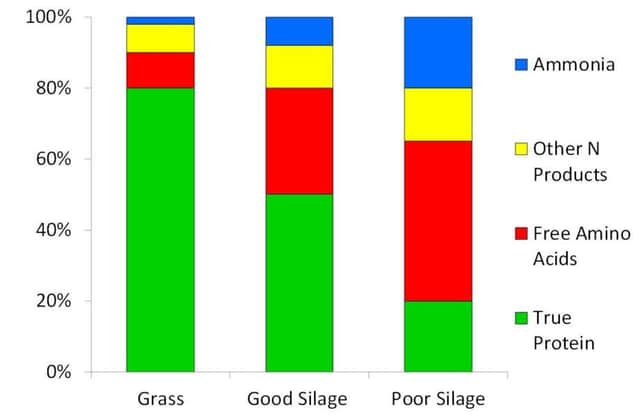Protecting protein in silage


If this time crucial time period is extended for any reason, a number of undesirable and wasteful processes can eat away at valuable nutrients, impacting on potential production and profitability.
Protein breakdown will take place during wilting, silo filling and the early stages of fermentation. This is when true protein is broken down to free amino acids, peptides and ammonia. The extent of this breakdown will have an effect on how ruminants will utilise the nitrogen in the silage.
Advertisement
Hide AdAdvertisement
Hide AdRapid wilting will reduce the time taken to reach the desired dry matter of above 30%. This can be done by using spreader mowers or tedding immediately after mowing and as required after that.
Once at the clamp, grass from each load should be spread in thin layers across a wide area and rolled constantly to ensure it is well compacted. This will ensure a high density silage which contains as little oxygen as possible, enabling the fermentation process to start as soon as possible. To preserve as much true protein as possible a rapid fermentation and fast pH decline is required. The best way to achieve this is by using Powerstart silage additive.
Powerstart contains the Aber F1 Lactobacillus Plantarum bacteria which has a proven track record of far quicker fermentation and associated pH decrease resulting in improved protein and sugar preservation in the silage. This has two significant consequences for the nutritional value of the silage.
The first is that by making use of all the sugars in grass, less of the available sugar is used during the fermentation which means that there is more sugar in the resultant silage and available to the cow. The second is that by accelerating the rate of fermentation the protein in the grass is preserved more effectively with a higher proportion of true protein and fewer free amino acids, something that will not show up on a silage analysis.
Advertisement
Hide AdAdvertisement
Hide AdAnd this is where the final unique benefit of Powerstart is evident. In silages with more free amino acids a large proportion of protein is lost as rumen ammonia which is excreted as urea into the blood and milk.
Converting ammonia into urea wastes energy which reduces the energy available for milk production. If less energy is available from the diet, the consequence in early lactation is that cows will be in extended negative energy balance and will lose more condition over a longer period of time which is well understood to have a negative effect on fertility, another aspect which can impact on profit margins.
Grass will contain around 80% true protein. In an ensiling system where best practice is not followed true protein values can be as low as 20% resulting in low productivity. By following best practice - including rapid wilting, good consolidation, good sealing and using Powerstart inoculant, 50 to 60% of the nitrogen can be preserved as true protein ensuring that production and profitability is maximised through winter.